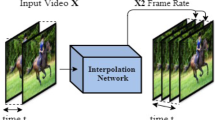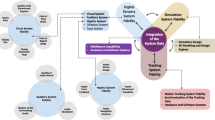Abstract
This paper deals with monitoring user perception of multimedia presentations in a Universal Multimedia Access (UMA) enabled system using objective no-reference (NR) metrics. These NR metrics are designed for an UMA-enabled system, in a novel architecture, for a multimedia viewer. The first metric measures block-edge impairments in a video frame at the receiver end, based on the observation that they occur in regions with low spatial activity. The second metric evaluates the quality of the reconstructed video frame in the event of packet loss. Here, the structure of the artifact is itself exploited for the evaluation. Both the metrics involve low computational complexity and are feasible for real-time monitoring of streaming video in a multimedia communication scenario. Further, in rate-adaptive streaming of video, these metrics could serve as feedback parameters to dynamically adapt the bit rates based on network congestion.
Similar content being viewed by others
References
Boyce J, Galianello R (1998) Packet loss effects on MPEG video sent over public internet. In: ACM international multimedia conference, pp 181–190
Caviedes J, Gurbuz S (2002) No-reference sharpness metric based on local edge kurtosis. In: Proceedings of the international conference on image processing, vol 3. Rochester, NY, pp 53–56, 22–25 September
Farias MCQ, Carli M, Mitra SK (2005) Objective video quality metric based on data hiding. IEEE Trans Consum Electron 51(3):983–992, August
Feamster N, Balakrishnan H (2002) Packet loss recovery for streaming video. In: International packet video workshop, April
Gao W, Mermer C, Kim Y (2002) A de-blocking algorithm and a blockiness metric for highly compressed images. IEEE Trans Circuits Syst Video Technol 12(12):1150–1159, December
Kimura J, Tobagi FA, Pulido JM, Emstad PJ (1999) Perceived quality and bandwidth characterization of layered MPEG-2 video encoding. In: SPIE intl. sym. on voice, video and data communications, September
Lu L, Wang Z, Bovik AC, Kouloheris J (2002) Full-reference video quality assessment considering structural distortion and no-reference quality evaluation of mpeg video. In: IEEE international conference on multimedia and expo. Yorktown Heights, NY, USA, pp 61–64
Marziliano P, Dufaux F, Winkler S, Ebrahimi T (2002) A no-reference perceptual blur metric. In: Proceedings of the international conference on image processing. vol 3. Rochester, NY, pp. 57–60, 22–25 September
NTT DoCoMo. Error generating software (1996) Provided to the MPEG Resilience Ad Hoc Group Reflector on 31st October
Pereira F, Burnett I (2003) Universal multimedia experiences for tomorrow. IEEE Signal Process Mag 20(2):63–73, March
Perkis A, Abdejaoued Y, Christopoulos C, Ebrahimi T, Chicharo JF (2001) Universal multimedia access from wired and wireless systems. Circuits Syst Signal Process; Special issue on Multimedia Communications 20(3):387–402
Suthaharan S (2003) A perceptually significant block-edge impairment metric for digital video coding. In: Proceedings ICASSP’2003, vol 3. Hong Kong, pp 681–684
Tektronix Test Sequences. ftp://ftp.tek.com/tv/test/streams/Element/index.html.
Verscheure O, Frossard P, Hamdi M (1999) User-oriented QoS analysis in MPEG-2 video delivery. Real-time Imaging 5:305–314
Video Quality Experts Group (VQEG). website: http://www.vqeg.org
Vlachos T (2000) Detection of blocking artifacts in compressed video. Electron Lett 36(13): 1106–1108
Wang Z. http://www.cns.nyu.edu/zwang/
Wang Y, Zhu Q (1998) Error control and concealment for video communication: A review In: Proceedings of the IEEE, vol 86, no 5, May
Wang Z, Bovik AC, Evans BL (2000) Blind measurement of blocking artifacts in images. In: Proceedings ICIP’00, vol 3, pp 981–984, September
Wang Z, Sheikh HR, Bovik AC (2002) No-reference perceptual quality assessment of JPEG compressed images. In: Proceedings ICIP’02, vol 1, pp 477–480, September
Winkler S (1999) A perceptual distortion metric for digital color video. In: Proceedings SPIE human vision and electronic imaging, vol 3644. San Jose, CA, USA, pp 175–184, January
Winkler S, Sharma A, McNally D (2001) Perceptual video quality and blockiness metrics for multimedia streaming applications. In: Proceedings 4th international symposium on wireless personal multimedia communications. Aalborg, Denmark, pp 553–556, September
Wu HR, Yuen M (1998) A generalized block-edge impairment metric for video coding. IEEE Signal Process Lett 70(3):247–278, November
Wu HR, Yuen M, Qiu B (1996) Video coding distortion classification and quantitative impairment metrics. In: International conference on signal processing, vol 2, pp 962–965, October
Yang F, Wan S, Chang Y, Wu HR (2005) A novel objective no-reference metric for digital video quality assessment. IEEE Signal Process Lett 12(10):685–688, October
Yuen M, Wu HR (1997) A survey of hybrid MC/DPCM/DCT video coding distortions. Signal Process 4(11):317–320, November
Author information
Authors and Affiliations
Corresponding author
Rights and permissions
About this article
Cite this article
Venkatesh Babu, R., Perkis, A. & Hillestad, O.I. Evaluation and monitoring of video quality for UMA enabled video streaming systems. Multimed Tools Appl 37, 211–231 (2008). https://doi.org/10.1007/s11042-007-0140-9
Published:
Issue Date:
DOI: https://doi.org/10.1007/s11042-007-0140-9




